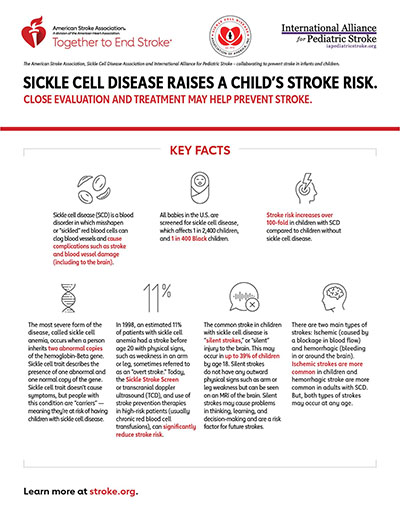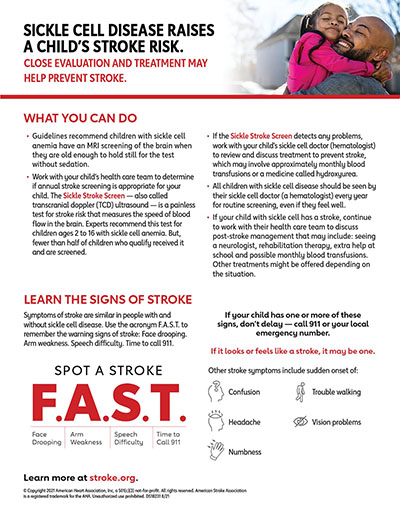Sickle Cell Disease and Pediatric Stroke Risk


Download the infographic (PDF)
The American Stroke Association, the Sickle Cell Disease Association, and the International Alliance for Pediatric Stroke – collaborating to prevent stroke in infants and children.
SICKLE CELL DISEASE RAISES A CHILD’S STROKE RISK. CLOSE EVALUATION AND TREATMENT MAY HELP PREVENT STROKE.
KEY FACTS
Sickle cell disease (SCD) is a blood disorder in which misshapen or “sickled” red blood cells can clog blood vessels and cause complications such as stroke and blood vessel damage (including to the brain).
All babies in the U.S. are screened for sickle cell disease, which affects 1 in 2,400 children, and 1 in 400 Black children.
Stroke risk increases over 100-fold in children with SCD compared to children without sickle cell disease.
The most severe form of the disease, called sickle cell anemia, occurs when a person inherits two abnormal copies of the hemoglobin-Beta gene. Sickle cell trait describes the presence of one abnormal and one normal copy of the gene. Sickle cell trait doesn’t cause symptoms, but people with this condition are “carriers” — meaning they’re at risk of having children with sickle cell disease.
In 1998, an estimated 11% of patients with sickle cell anemia had a stroke before age 20 with physical signs, such as weakness in an arm or leg, sometimes referred to as an “overt stroke.” Today, the Sickle Stroke Screen or transcranial doppler ultrasound (TCD), and use of stroke prevention therapies in high-risk patients (usually chronic red blood cell transfusions), can significantly reduce stroke risk.
The common stroke in children with sickle cell disease is “silent strokes,” or “silent” injury to the brain. This may occur in up to 39% of children by age 18. Silent strokes do not have any outward physical signs such as arm or leg weakness but can be seen on an MRI of the brain. Silent strokes may cause problems in thinking, learning, and decision-making and are a risk factor for future strokes.
There are two main types of strokes: Ischemic (caused by a blockage in blood flow) and hemorrhagic (bleeding in or around the brain). Ischemic strokes are more common in children and hemorrhagic stroke are more common in adults with SCD. But, both types of strokes may occur at any age.
WHAT YOU CAN DO
- Guidelines recommend all children with sickle cell anemia have an MRI screening of the brain when they are old enough to hold still for the test without sedation.
Work with your child’s health care team to determine if annual stroke screening is appropriate for your child. The Sickle Stroke Screen — also called transcranial doppler (TCD) ultrasound — is a painless test for stroke risk that measures the speed of blood flow in the brain. Experts recommend this test for children ages 2 to 16 with sickle cell anemia. But, fewer than half of children who qualify received it and are screened.
- If the Sickle Stroke Screen detects any problems, work with your child’s hematologist to review and discuss treatment to prevent stroke, which may involve approximately monthly blood transfusions, or a medicine called hydroxyurea.
- All children with sickle cell disease should be seen by their sickle cell doctor (a hematologist) every year for routine screening, even if they feel well. If your child with sickle cell has a stroke, continue to work with their health care team to discuss post-stroke management that may include: seeing a neurologist, rehabilitation therapy, extra help at school and possible monthly blood transfusions. Other treatments might be offered depending on the exact issues and situation.
LEARN THE SIGNS OF STROKE
Symptoms of stroke are similar in people with and without sickle cell disease.
Use the acronym F.A.S.T. to remember the warning signs of stroke:
- Face drooping.
- Arm weakness.
- Speech difficulty.
- Time to call 911.
Spot a Stroke F.A.S.T F face drooping A arm weakness S speech difficulty T time to call 911 If your child has one or more of these signs, don’t delay – call 911 or your local emergency number.
If it looks or feels like a stroke, it may be one.
Other stroke symptoms include sudden onset of:
- Confusion
- Headache
- Numbness
- Trouble walking
- Vision Problems
Learn more at stroke.org




